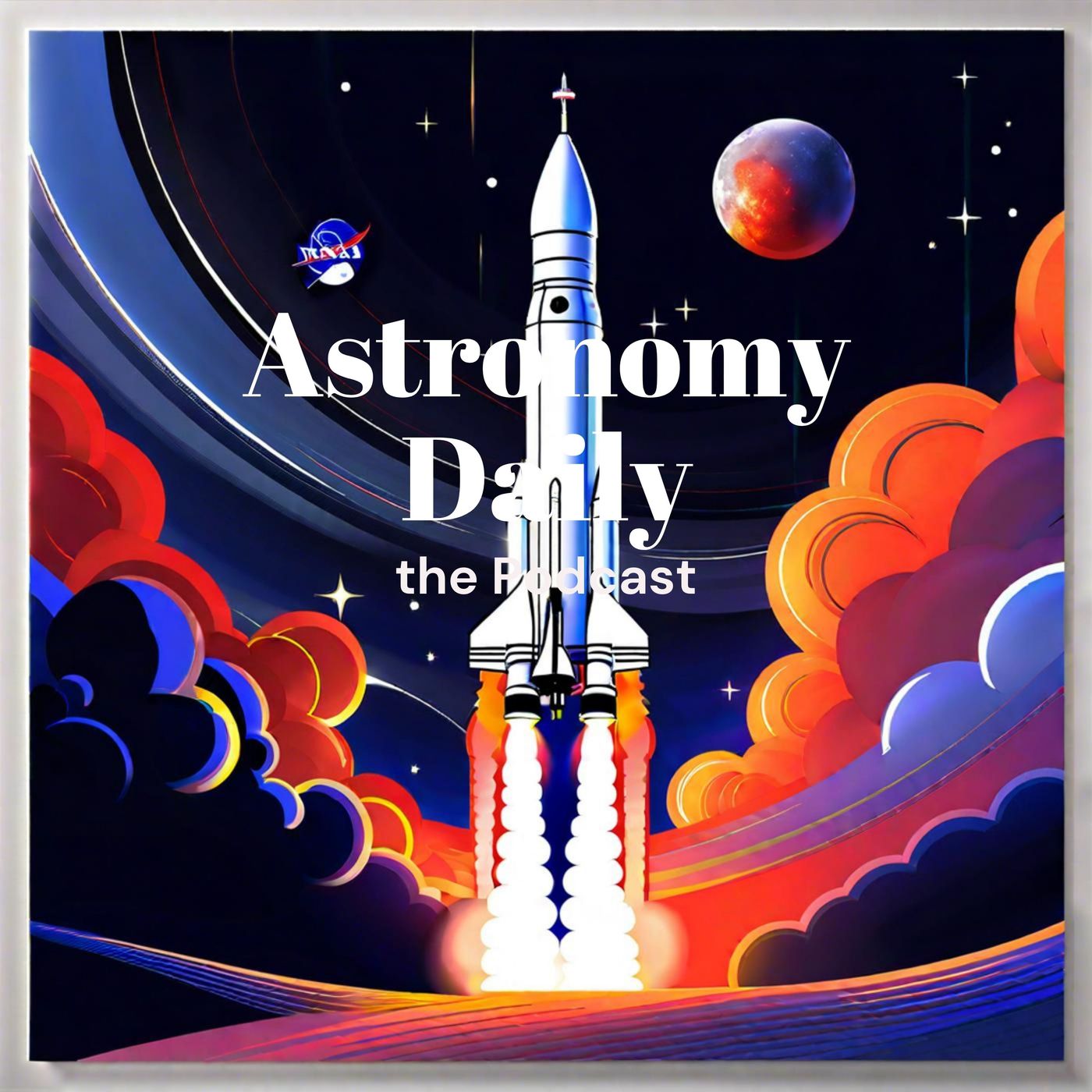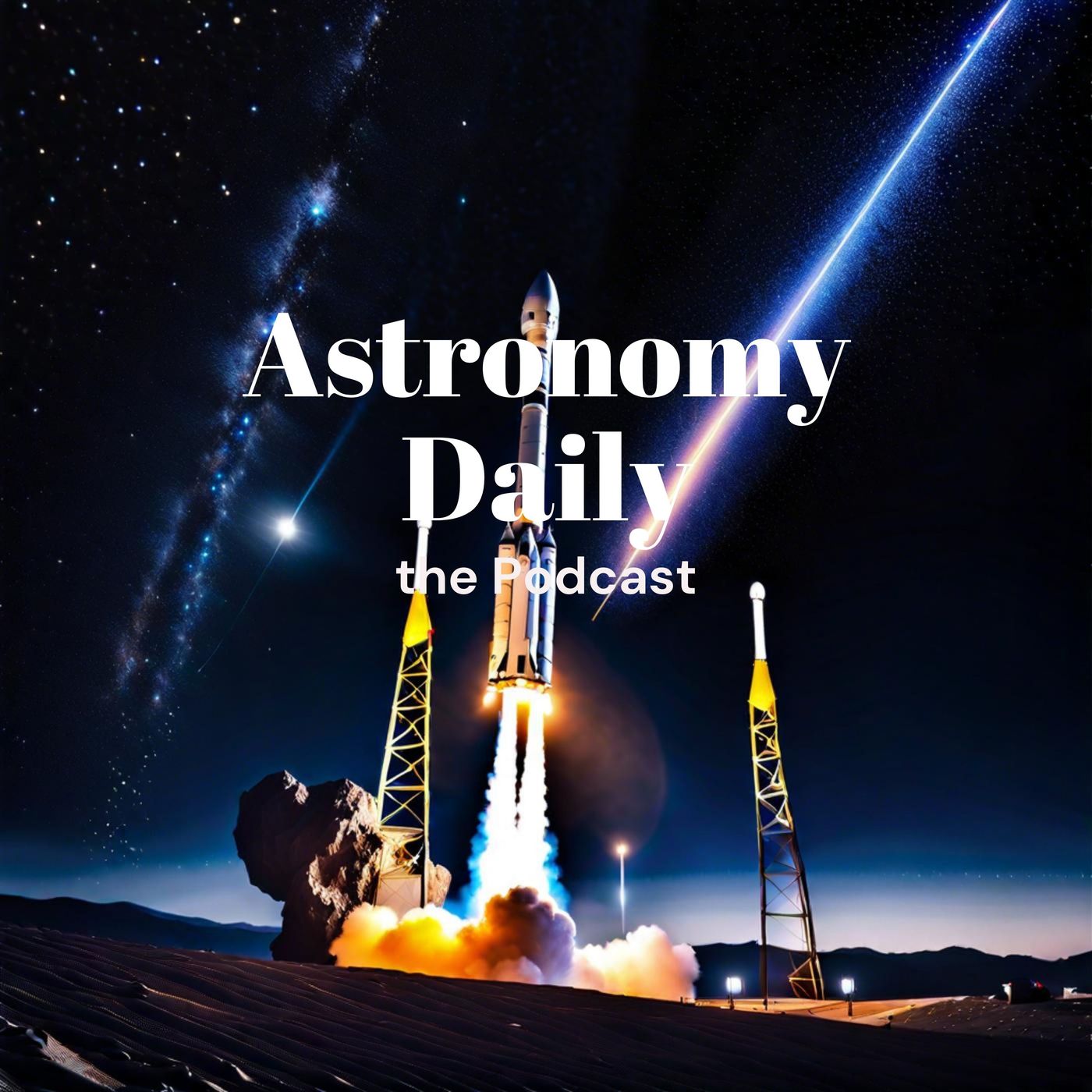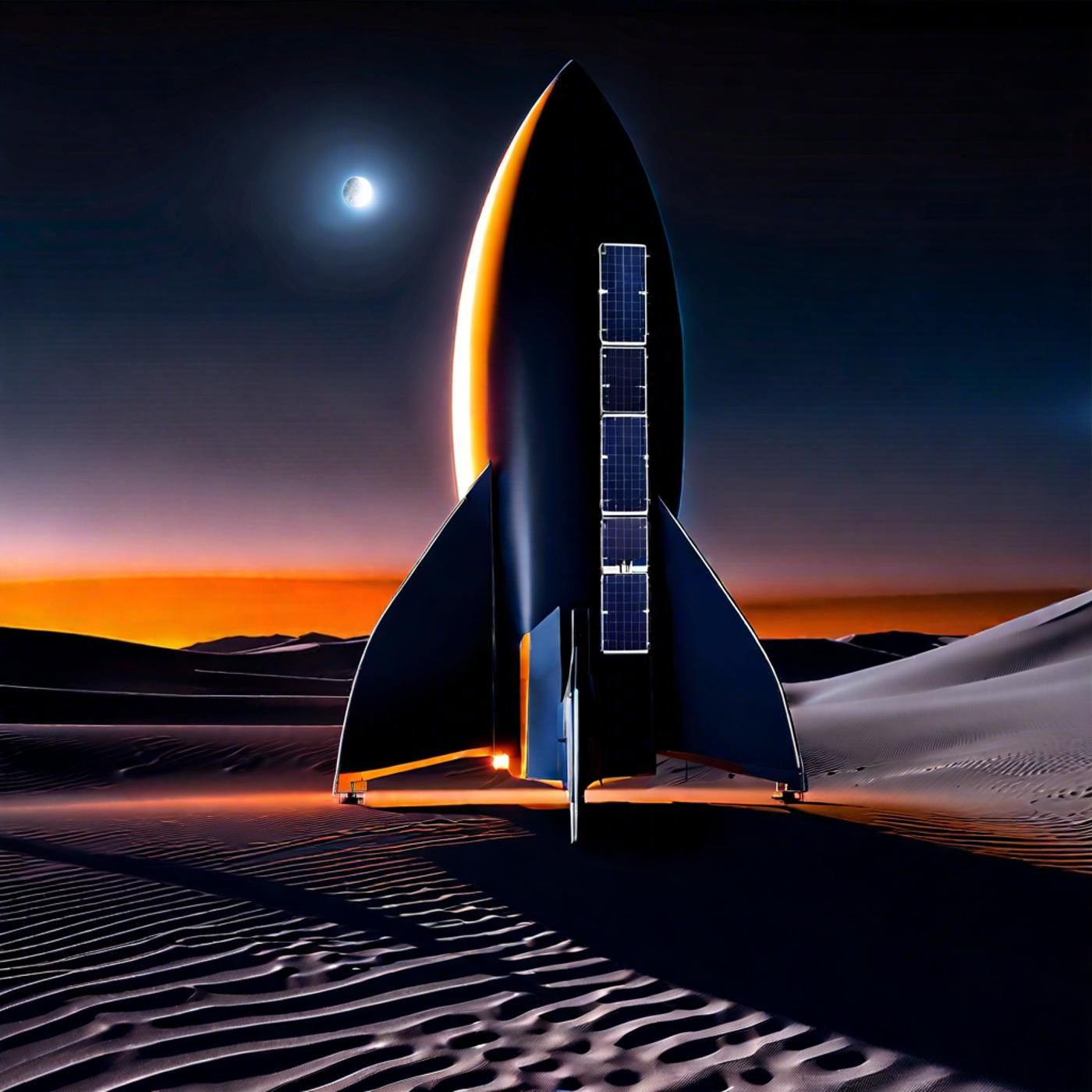S03E136: Starbase Milestones, Space Junk Solutions, and Astronaut Adventures

Welcome to Astronomy Daily, your go-to Podcast for the latest news and insights in the world of space and Astronomy. I'm your host, Anna. Today we'll start with SpaceX's rapid progress at Starbase, where they're making significant advances with their...
Welcome to Astronomy Daily, your go-to Podcast for the latest news and insights in the world of space and Astronomy. I'm your host, Anna. Today we'll start with SpaceX's rapid progress at Starbase, where they're making significant advances with their launch towers and preparing for future missions. Then we'll move on to a fascinating new initiative from Japanese company Astroscale, which aims to tackle the growing problem of space junk with an innovative $90 million mission. Next, we'll dive into some exciting research being conducted on the International Space Station by NASA astronauts Butch Wilmore and Suni Williams. Finally, we'll explore Harvard professor Avi Loeb's intriguing hypothesis about how advanced civilizations might use black holes as a power source. Let's dive in.
- **SpaceX's Rapid Progress at Starbase**: SpaceX has done it again. They've stacked launch tower two at orbital launch pad B at Starbase, Texas, in record time. This rapid assembly, completed in just 41 Daily, is an impressive feat of engineering and logistics, setting the stage for their innovative chopstick system designed to catch boosters mid-air.
- **Astroscale's $90 Million Space Junk Removal Mission**: Japanese company Astroscale recently secured a $90 million contract to remove a bus-sized rocket stage from orbit. This mission, funded by the Japanese Aerospace Exploration Agency (JAXA), is a significant step forward in space sustainability. Astroscale's project, named ADRAS-J2, aims to tackle the issue of space debris head-on, using advanced robotic technologies to clean up our orbits. The mission involves using a robotic arm to grab the tumbling rocket stage and pull it into Earth's atmosphere, where it will burn up on reentry.
- **Exciting Research on the ISS**: NASA astronauts Butch Wilmore and Suni Williams have been conducting groundbreaking research on the International Space Station (ISS). Their work includes experiments on plant growth in space, fluid physics, and utilizing Astrobee, a set of free-flying robots designed to assist with chores and maintenance.
- **Avi Loeb's Black Hole Moon Hypothesis**: Harvard professor Avi Loeb has sparked intriguing discussions with his latest hypothesis, the Black Hole Moon. This groundbreaking idea suggests that advanced civilizations could exploit black holes as potent energy sources, potentially providing a technosignature detectable from Earth. Loeb builds upon Roger Penrose's concept of extracting energy from a rotating black hole's accretion disk and proposes the creation or capture of a small black hole weighing about 100,000 tons. This black hole could emit a massive continuous energy output through Hawking radiation, potentially powering an entire planet and even consuming waste. Detecting such a system could revolutionize our search for extraterrestrial intelligence.
For more space news, be sure to visit our website at astronomydaily.io. There you can sign up for our free Daily newsletter, read insightful blog posts, and catch up on all the latest space and Astronomy news with our constantly updating newsfeed.
Don't forget to listen to all our previous episodes as well. You can also follow us on social media. Just search for AstroDailyPod on Facebook, X, YouTubeMusic, and TikTok to stay connected with our community and never miss an update.
Until next time, keep your eyes on the stars.
Sponsor Links:
Nordpass
NordVPN
Malwarebytes
Proton...
Welcome to Astronomy Daily, your go-to podcast for the latest news and insights in the world of space and astronomy. I'm your host, Anna. Today, we'll start with SpaceX's rapid progress at Starbase, where they're making significant advances with their launch towers and preparing for future missions. Then, we'll move on to a fascinating new initiative from Japanese company Astroscale, which aims to tackle the growing problem of space junk with an innovative $90 million mission. Next, we’ll dive into some exciting research being conducted on the International Space Station by NASA astronauts Butch Wilmore and Suni Williams. Finally, we'll explore Harvard Professor Avi Loeb's intriguing hypothesis about how advanced civilizations might use black holes as a power source. Let's dive in!
SpaceX has done it again! They've stacked Launch Tower 2 at Orbital Launch Pad B at Starbase, Texas, in record time. Now, you might be wondering what this all means and why it’s such a big deal. Well, let me break it down for you. First, the rapid assembly of Launch Tower 2 is an impressive feat of engineering and logistics. SpaceX managed to pull this off in just 41 days, which is faster than the construction of their previous towers. This quicker completion is already causing waves in the aerospace community. But it’s not just about speed. The stacking of the tower signals that SpaceX can now move forward with adding their innovative chopstick system. This is a significant step forward, particularly for the upcoming Flight 5 mission. The system is a complex piece of technology designed to catch boosters—yes, catch boosters!—mid-air and then lower them safely back to the ground.
Flight 5 will see Ship 30 and Booster 12 at the forefront. Both vehicles are ready to fly, which has many enthusiasts buzzing with excitement. Teams have even decorated Ship 30 with a unique Mechazilla decal, symbolizing the critical goal of this mission: catching the booster. Previous missions never featured such decals, but given the importance of Flight 5, every detail, even the aesthetic ones, is being given due attention. Now, let's talk a bit about the technical aspects that go into making these missions successful. SpaceX requires regulatory approval for their Return to Launch Site (RTLS) approach, which involves the booster coming back to the launch site instead of landing on a drone ship at sea. This method has its own set of challenges and complexities. Even though the vehicles seem ready, the mission is still weeks away as they await final regulatory green lights.
Meanwhile, over at Pad A, preparations have been ongoing for the booster catch. Teams are not taking any chances; they’ve been testing the chopstick arms by “slapping” Booster 14.1 with them. This test involves simulating the catch process to ensure everything works smoothly during the actual mission. This time, they’ve even used new bumpers made of a compressive metal structure instead of foam or rubber, showing their commitment to continuously improving their techniques. Notably, after these tests, the team exposed all the weld lines on the chopstick arms and added doubler plates to strengthen them. They also installed a new set of bumpers and changed some of the landing rail dampers to enhance the stability and safety of the catch process. It's obvious that each modification is aimed at refining the catch mechanism to utmost reliability.
But it doesn’t stop there. Crews have also added larger gusset plates to the first section of the tower, bolstering the connection between diagonal cross beams and horizontal beams. This is likely in anticipation of the upcoming catch attempt. And they’ve also added a stop on the Ship Quick Disconnect (SQD) arm, which will protect it from the compressive loads generated by the rocket’s exhaust. All this busy work at Pad A suggests that predicting the exact timing of the next flight will be tricky. It’s a bit like waiting for all the pieces of a giant puzzle to come together. You can’t rush the process; every bit of hardware and every logistical detail needs to align perfectly. Shifting our focus over to Pad B, this is where some equally exciting developments have taken place. Pad B's tower at Starbase is now fully stacked, and it's already more complete than its predecessors, with all commodity lines pre-installed. This cuts down on a lot of the time-consuming tasks needed post-stacking.
So there you have it! SpaceX's record-breaking stacking of Launch Tower 2 not only brings us closer to witnessing the awe-inspiring Flight 5 but also showcases the relentless innovation and precision driving today’s space exploration. Stay with us, as the sky is not the limit anymore—space is!
Next up, Space debris has become an increasingly pressing issue, and we're seeing some exciting developments in how to tackle this challenge. Japanese company Astroscale recently secured a $90 million contract to remove a bus-sized rocket stage from orbit. This mission, funded by the Japanese Aerospace Exploration Agency, or JAXA, is a significant step forward in space sustainability, utilizing advanced robotic technologies to clean up our orbits. Astroscale's project, named ADRAS-J2, aims to address the issue of space debris head-on. Space debris poses a considerable risk to both operational satellites and future space missions, and cleaning up this orbital junk is critical for long-term space sustainability. Imagine the challenge: a 3-ton, 36-foot-long rocket stage, just floating around in space, creating a potential hazard. Astroscale's mission is to remove this behemoth by the end of the decade, demonstrating a critical technology for space cleanup.
The ADRAS-J2 mission builds on the company’s previous efforts under the ADRAS-J initiative, where they recently conducted an orbital inspection of a 12-year-old upper stage of a Japanese H-2A rocket. The inspection confirmed that the payload adapter, which will be used to grab the rocket stage, is still intact. This finding is crucial because unprepared objects in orbit pose additional challenges; they aren’t fitted with technologies that make docking or removal straightforward. This is where Astroscale's innovative approach and advanced technology come into play. For this mission, they plan to use a robotic arm to grab the tumbling rocket stage and pull it into Earth's atmosphere, where it will burn up on re-entry. The success of this mission could pave the way for similar efforts in the future, helping to clear the cluttered orbital space and make it safer for new missions.
But that's not all Astroscale is working on. They have two other space debris removal missions in progress. In July, the Tokyo-based company signed a contract with satellite operator Eutelsat OneWeb to remove a OneWeb satellite equipped with a magnetic docking plate from orbit by 2027. This mission aims to prove the feasibility of removing smaller, prepared objects from orbit. Another project they have in the works is currently being considered by the U.K. Space Agency and involves removing two old British satellites using a spacecraft fitted with a robotic arm. The urgency of addressing space debris cannot be overstated. According to the European Space Agency, over 40,500 pieces of space junk larger than 4 inches are hurtling through space. This includes old satellites, spent rocket stages, and fragments generated from previous collisions and explosions. Alongside this, there are an estimated 1.1 million objects between 0.4 inches to 4 inches in size, and even more pieces smaller than 0.4 inches.
Next, you may be wondering what the two Boeing Starliner astronauts have been doing during their extended stay on the ISS. Well, they've hardly been sitting around twiddling their thumbs. Since the launch of the International Space Station over two decades ago, it has been a hub of continuous scientific research and innovation. From its vantage point in low Earth orbit, the ISS offers unique opportunities to conduct experiments that aren't possible on our home planet. Recently, NASA astronauts Butch Wilmore and Suni Williams have been at the helm of these operations, contributing to a myriad of activities designed to advance both earthly and cosmic knowledge. Butch Wilmore and Suni Williams, both seasoned space travelers, arrived on the ISS on June 6 as part of NASA’s Boeing Crew Flight Test. As veterans of two previous spaceflights each, they are no strangers to the rigors and rewards of living and working in microgravity. Upon their arrival, the pair wasted no time immersing themselves in station life, joining the Expedition 71 crew in ongoing scientific endeavors and maintenance tasks critical to the station's operation.
One of the key areas of their research focuses on plant growth in space, an endeavor that holds immense potential for future missions to the Moon, Mars, and beyond. The Plant Water Management investigation is particularly fascinating as it examines how various techniques can be used to provide adequate water and nutrition to plants in the absence of gravity. Utilizing the physical properties of fluids such as surface tension and wetting, this experiment aims to develop hydroponic systems that could be used in long-duration space missions. Imagine a future where astronauts can reliably grow their own food while journeying through space, significantly reducing the need for resupply missions. Complementing this is the Vegetable Production System, known as Veggie, which has already seen success in growing fresh produce and flowers aboard the ISS. Such fresh foods not only offer nutritional benefits but also boost crew morale. Wilmore has been actively involved in preparing Veggie for future experiments by installing a light meter that will help adjust light settings for optimal plant growth. This research is not just groundbreaking but offers a tangible taste of home for astronauts on long-term missions.
Beyond botany, Wilmore and Williams have also been involved in fluid physics research, another critical area given the distinct behavior of fluids in microgravity. These studies are essential for the development of everything from more efficient water systems for space habitats to cooling systems for spacecraft. In addition to scientific experiments, the astronauts have been utilizing Astrobee, a set of free-flying robots designed to assist with chores and maintenance. Williams has been working closely with these robots, allowing ground controllers to remotely map the interior of the ISS, practice docking maneuvers, and test the robots' capabilities in carrying out various tasks. These automated helpers are not just a glimpse into the future of space exploration; they’re a functional part of station life now, freeing up human astronauts to focus on more complex tasks.
Education and outreach are also key components of their mission. In early August, Williams engaged in a space-to-Earth call using the Ham Radio to connect with students from Banda Aceh, Indonesia. Photography, while seemingly a leisure activity, is another significant role that astronauts undertake. Both Wilmore and Williams have been busy capturing stunning images of Earth from the ISS, adding to a valuable data set that helps scientists monitor environmental changes over time. These snapshots from space also have a psychological benefit for the astronauts, offering them a moment of beauty and connection with home. As their mission continues, Wilmore and Williams remain dedicated to supporting daily operations aboard the ISS, conducting ever-more-complex experiments, and sharing their experiences with the world. Their work furthers our understanding of the fundamental science that will be crucial for future interplanetary missions and enhances the quality of life on Earth through technological and scientific advancements.
For the latest updates on NASA’s commercial crew activities, including the Boeing Crew Flight Test, visit the Commercial Crew Program blog. And for daily insights into the research being conducted in microgravity, make sure to check out the space station blog. From fluid dynamics and robotic innovations to educational outreach and the stunning beauty of Earth seen from space, Butch Wilmore and Suni Williams are ushering in a new era of space exploration that promises to benefit humanity for generations to come.
Finally today, something a little different. Professor Avi Loeb of Harvard University has once again sparked intriguing discussions with his latest hypothesis: the "Black Hole Moon." This groundbreaking idea revolves around the concept that advanced civilizations could exploit black holes as potent energy sources, potentially providing a technosignature—an observable indicator of advanced extraterrestrial civilizations. The hypothesis rests on a foundation of some well-established astrophysical ideas, primarily concerning the nature of black holes and the unique emissions they produce. Loeb builds upon Roger Penrose's concept proposed in 1971, where energy could be extracted from a rotating black hole's accretion disk. The accretion disk is an area where matter spirals into the black hole, accelerating to near-light speeds and releasing energy in multiple wavelengths. Over the years, various researchers have speculated that advanced civilizations might harness this energy, potentially rendering it a detectable technosignature.
In his recent paper, Avi Loeb takes this idea a step further by suggesting how a "Black Hole Moon" could orbit a planet and serve as an energy source. This hypothetical scenario involves creating or capturing a small black hole weighing about 100,000 tons. Now, you might wonder, how could such a tiny yet incredibly dense object power an entire planet? The answer lies in a phenomenon known as Hawking Radiation, theorized by Stephen Hawking in 1974. According to Hawking's theory, black holes emit a spectrum of particles and radiation, potentially providing a massive, continuous energy output. Loeb proposes that an advanced civilization could maintain this miniature black hole by feeding it a small amount of matter—just over two kilograms per second—and in return, it would yield a staggering 40 quadrillion watts of power. To put this into perspective, that amount of energy output is thousands of times greater than Earth's current energy consumption needs. Essentially, this black hole would act as the most efficient engine imaginable, converting mass to energy with perfect efficiency.
But the benefits don't stop there. This black hole could consume any form of matter, even waste, making it an ideal solution for both energy production and waste management. Imagine a world where every scrap of garbage could be turned into clean, inexhaustible energy. Such a system could function for millions of years, provided there is matter to sustain it. Detecting such a system from Earth poses another exciting opportunity. Loeb suggests that if astronomers were to come across a rogue planet illuminated by gamma rays—without any visible stellar companion—this could be the telltale sign of a "Black Hole Moon." This could revolutionize our search for extraterrestrial intelligence by expanding our understanding of what technosignatures might look like. What sets this theory apart is its blend of feasibility and innovation. While the creation and maintenance of such a black hole are beyond our current technological capabilities, Loeb notes that the theoretical groundwork aligns with known physics. A civilization capable of feats like quantum tunneling to create baby universes, as Loeb has suggested in another op-ed, would find a black hole-powered engine considerably less challenging to manage.
These speculations, wild as they may seem, pave the way for the kind of imaginative thinking that could one day propel us to extraordinary discoveries.
That wraps up today's episode of 'Astronomy Daily.' Thank you for tuning in, and I hope you enjoyed our exciting lineup of stories about SpaceX's latest advancements, Astroscale's innovative space junk removal mission, the groundbreaking research on the ISS, and the intriguing possibilities of black hole energy sources. As always, I've been your host, Anna. For more space news, be sure to visit our website at astronomydaily.io. There, you can sign up for our free daily newsletter, read insightful blog posts, and catch up on all the latest space and astronomy news with our constantly updating newsfeed. Don't forget to listen to all our previous episodes as well. You can also follow us on social media—just search for AstroDailyPod on Facebook, X, YouTube, and TikTok to stay connected with our community and never miss an update.
Until next time, keep your eyes on the stars!
New to Astronomy Daily - The Podcast?
Here are some great episodes to start with.



















